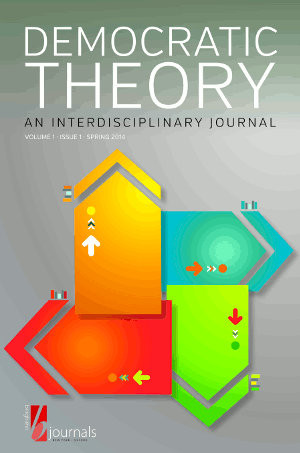Democratic Theory
Berghahn Journal
Deadline: Wed, 16 Dec 2020
Contact: Jean-Paul.Gagnon@canberra.edu.au


Marginalized Meanings of Democracy in the World
What are they? Why do they matter? How is it that they differ? Where are they
found? When are they from? Who do (or do not) they include? Can they work
together?
A call for papers for up to two special issues
by Jean-Paul Gagnon and Alexander Weiss
The symbol known to many as “democracy” or “démocratie / demokratie / democrazia / democracia / etc.,” seems to have always been associated with ambiguity and pluralism in its meanings and practices since, at least, the earliest records of when that symbol was issued in its ancient Grecian format. This is not to say that the modes of government, governance, and society that the Greeks termed democracy were all invented by them—we reject this premise and understand the “births” of these concepts to have happened in diverse locations, to have manifested independently more than once across time, space, language; and for some of democracy’s meanings and practices to have come from much older polities and to have existed under names different than “democracy / Δημοκρατία”.
Pace Plato’s children, advocates for the one ideal meaning of democracy to rule them all: should you take umbrage with the paragraph above we encourage you to quarrel with Thorkild Jacobsen (1943), Arne Naess (1956), Jens A. Christophersen (1966), Martin Bernal (1987), Muhlberger and Paine (1993), John Markoff (1999), Glenn E. Perry (2000), Yves Schemeil (2000), John Keane (2009), Isakhan and Stockwell (2011 & 2012), Francis Fukuyama (2011), Eric W. Robinson (2011), Chou and Beausoleil (2015), Kurunmäki, Nevers and te Velde (2018), Borlenghi et. al., (2019), David Stasavage (2020), de Sousa Santos and Mendes (2020), Eduardo Posada-Carbó (2020), and the list goes on. It is, we think, enough to state that Aristotle is credited by Naess (1956) with giving seven different definitions of democracy in his Politics and that the options to choose from, as to what democracy means and how it may come to be practised, has only grown in number, variety, and location since then. The extant literature speaks for itself. The above stated, positions against the plurality of democracy’s meanings are, however, welcome and invited.
An Imbalance in the Diversity of Democracy’s Ideas:
Whilst the exact number of meanings for democracy is not known, Naess (1956) for example collected 338 definitions of democracy, Collier & Levitsky (1997) claim to have recorded 550 sub-types of democracy, and Gagnon (2020a) lists over 3,500 “complex designators” of democracy (i.e. linguistic artefacts like representative democracy, deliberative democracy, patrimonial democracy, etc.,), some meanings are better known, and therefore more widely practiced, or entertained as possible future practices, than the majority of others.
The Google n-Gram can be used to show, at least among searchable books inside the Google Books storehouse, the use-frequency of democracy’s concepts over the period of, for example, 1990-2019 (or any other time period of your choosing). Figure one, below, shows that direct and deliberative concepts of democracy are prominent whilst representative democracy (once du jour) is now in the doldrums, illiberal democracy has slowly been growing in use whilst despotic democracy - a concept we should be fiercely examining today (see, e.g., Keane’s The New Despotisms [2020] or Applebaum’s Twilight of Democracy [2020] for reasons why) - has as yet to
emerge from obscurity. Imagine, for example, inputting the several thousand complex designators into this measure: the gross majority, we hope you can trust us in accepting, do not share anywhere near the use-frequency of direct or deliberative democracy and, in fact, fall far below even representative democracy.
Schedule:
Democratic Theory hopes to publish two special issues on the marginalized meanings of democracy in the world in its 8th volume, 2nd issue, of Winter (Northern) 2021 and its 9th volume, 1st issue, of Summer (Northern) 2022. The latter issue will be advanced in the calendar so that it will be published slightly after the former. Considering the requirements of first editorial review, with the possibility of revisions, then external peer-review, with the possibility of further revisions, we ask that:
(1) 150-word abstracts be sent to the editors (below) by December 15, 2020. The editors will read, discuss, and may thereafter invite authors to submit full articles.
(2) The full articles invited are to be submitted by April 1st, 2021, for initial reading by the editors. Articles may be returned to author(s) for revision prior to formal, external,
peer-review.
(3) External peer-review and the required revision of articles is to be completed by July 15, 2021, or as possible thereafter in the case of major revisions with a resubmission requirement. Any paper that passes peer-review, but misses the deadline for the special issues, will be slated for publication in a later volume.
Contact:
Please send correspondence (i.e. questions, comments, thoughts) to both Jean-Paul Gagnon (Jean-Paul.Gagnon@canberra.edu.au) and Alexander Weiss (1weiss@web.de).











